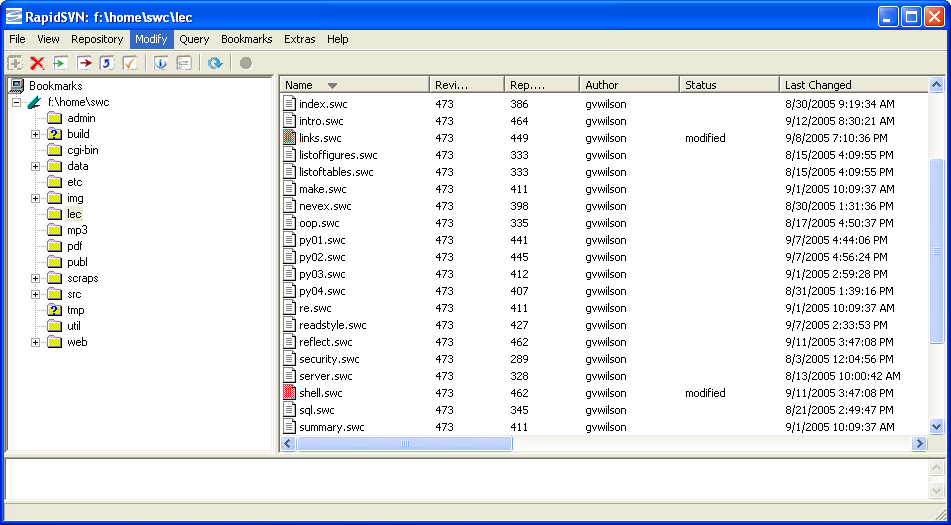

- RAPIDSVN FOR UBUNTU INSTALL
- RAPIDSVN FOR UBUNTU PASSWORD
- RAPIDSVN FOR UBUNTU PROFESSIONAL
- RAPIDSVN FOR UBUNTU MAC
As always I recommend emacs, especially using doom emacs configuration framework.
RAPIDSVN FOR UBUNTU INSTALL
Thanks to Canonical’s collaboration with NVIDIA GPU drivers are cryptographically signed and make your setup much more secure.įor all the basic software development tools Ubuntu gets you covered, using apt install or snap install you can have your favorite IDE or editor one command away.
RAPIDSVN FOR UBUNTU PROFESSIONAL
NVIDIA GPU – there are RTX or Quadro devices for professional workstations but a gaming GPU from 20XX or 30XX series would be good as well.At least 16GB of RAM, preferred 32GB or more.Of course, this depends on your budget, but the reasonable setup I could recommend is: You can find out more about it on Ubuntu website. Ubuntu is also the most popular operating system on public clouds so whatever you develop locally you can easily move to production without worrying about compatibility issues.Ĭanonical is working with many partners to make AI/ML experience best for developers. Ubuntu is the most popular Linux distribution amongst data professionals because it’s easy to use, and lets you focus on your job, instead of tinkering with the OS. If you really like the ecosystem you can cut it with a MacBook and eGPU enclosure but it’s not supported anymore.Īnother option would be Windows, and using WSL you can have a decent development environment where all tools and libraries work well but this option is still a niche in the machine learning community for now, and most of the community runs, tests and writes tutorials based on Linux.
RAPIDSVN FOR UBUNTU MAC
We can drop Mac immediately, because it does not have an option to include NVIDIA GPU, and you need to have it for any serious model training. In terms of operating systems for your local environment, you have a choice of Linux, Windows, and Mac. Having your own machine makes a lot of sense. for compliance or regulatory reasons.Īdditionally, I like to be able to take my work with me on a trip, and sometimes I’m not within range of a fast internet connection. If you are an experienced professional you will always meet a customer which cannot put their data on a public cloud, ie. If you are starting your career it’s better to understand exactly how all the pieces are working together, experiment with many tools and frameworks, and do it in a cost-effective way. Nevertheless, every data scientist needs a local environment. They are also great in terms of productizing your solution and exposing an inference endpoint. You can set up a VM, container, or use a ready-made environment that presents you with a Jupyter notebook. Public clouds offer a great set of solutions for data professionals. I would however recommend reading the reasoning behind certain choices to understand why this is the recommended setup. You can view the committed files in a browser.TLDR If you just want a tutorial to set up your data science environment on Ubuntu using NVIDIA RAPIDS and NGC Containers just scroll down. svn add checkout1.txt checkout2.txtĬommit the added files. cd checkout/Īdd those created files for committing. Install Apache SVN (Subversion) on Debian 9 – Subversion CheckOutĬreate test files for committing on the testrepo repository.
RAPIDSVN FOR UBUNTU PASSWORD
Store password unencrypted (yes/no)? yes <- Store Password Of the 'store-plaintext-passwords' option to either 'yes' or 'no' in You can avoid future appearances of this warning by setting the value Your system so that Subversion can store passwords encrypted, if Password for 'raj': **** Subversion RepositoryĬan only be stored to disk unencrypted! You are advised to configure

Authentication realm: Subversion Repository mkdir checkoutĬheck out the files contained within the directory to the testing repository. Install Apache SVN on Ubuntu 18.04 – Apache SVN Revision 0Ĭreate a directory called “checkout”. Upon successful login, you will get the page like below. Install Apache SVN on Ubuntu 18.04 – Apache SVN Authentication Authenticate yourself with the username and password.


 0 kommentar(er)
0 kommentar(er)
